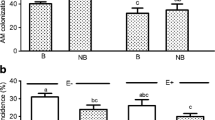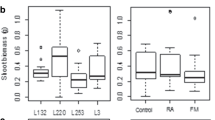Abstract
Ornamental crop production is increasing worldwide and petunia is nowadays a major bedding plant with high economic impact. To meet growing demands, a high production of quality nursery plants is needed. However, production in greenhouses is confronted by two main problems: fertiliser-induced salinity and pathogen attack like by Thielaviopsis basicola which both cause high losses. Moreover, there is increasing consumer demand for crops produced by environment-friendly practices. The application of arbuscular mycorrhizal (AM) fungi can present an appropriate approach to avoid excessive use of fertilisers and pesticides. Here, we report studies of the interaction between Petunia hybrida and the AM fungus Glomus mosseae in abiotic and biotic stress situations. Root colonisation by G. mosseae, although very low, was able to compensate phosphate deficiency in the substrate and resulted in increased plant dry matter, water and phosphorus content in the shoots. However, these positive effects were attenuated at high salt concentrations (abiotic stress). In contrast, disease symptoms caused by the root pathogen T. basicola (biotic stress) were significantly reduced in G. mosseae-colonised plants. Such protective effects were not achieved with the AM fungi Glomus intraradices and Gigaspora rosea, and a negative effect of the pathogen on root colonisation by G. intraradices was observed. This shows for the first time under nursery practice conditions that G. mosseae can compensate the negative impact of lower levels of phosphate fertilisation on plant growth in a soilless production system and induce bioprotection of petunia against T. basicola. Based on the different effects observed with the three AM fungi, petunia can provide an experimental system to define the molecular mechanisms underlying mycorrhiza-induced resistance against root pathogens.





Similar content being viewed by others
References
Al-Karaki G.N., Hammad R., Rusan M. (2001) Response of two tomato cultivars differing in salt tolerance to inoculation with mycorrhizal fungi under salt stress. Mycorrhiza 11, 43–47.
Bodker L., Kjoller R., Kristensen K., Rosendahl S. (2002) Interactions between indigenous arbuscular mycorrhizal fungi and Aphanomyces euteiches in field-grown pea. Mycorrhiza 12, 7–12.
Breuillin F., Schramm J., Hajirezaei M., Ahkami A., Favre P., Druege U., Hause B., Bucher M., Kretzschmar T., Bossolini E., Kuhlemeier C., Martinoia E., Franken P., Scholz U., Reinhardt D. (2010) Phosphate systemically inhibits development of arbuscular mycorrhiza in Petunia hybrida and represses genes involved in mycorrhizal functioning. Plant J. 64, 1002–1017.
Chavez W., Di Benedetto A., Civeira G., Lavado R. (2008) Alternative soilless media for growing Petunia hybrida and Impatiens wallerana: Physical behavior, effect of fertilization and nitrate losses. Bioresource Technol. 99, 8082–8087.
David C.H. (2008) Suppression of Thielaviopsis basicola by two fungicides applied to sandy loam soils in New Mexico. Plant Disease 64, 1011–1012.
Dreistadt S.H. (2001) Integrated pest management for floriculture and nurseries. University of California, Davis, CA.
Fakhro A., Andrade-Linares D.R., Susanne von Bargen S.; Bandte M., Büttner C., Grosch R., Schwarz D., Franken P. (2010) Impact of Piriformospora indica on tomato growth and on interaction with fungal and viral pathogens. Mycorrhiza 20, 191–200.
Garmendia I., Goicoechea N., Aguirreolea J. (2004) Effectiveness of three Glomus species in protecting pepper (Capsicum annuum L.) against verticillium wilt. Biol. Control 31, 296–305.
Gaur A., Adholeya A. (2000) Growth and flowering in Petunia hybrida, Callistephus chinensis and Impatiens balsamina inoculated with mixed AM inocula or chemical fertilizers in a soil of low P fertility. Sci. Hort. 84, 151–162.
Gerats T., Vandenbussche M. (2005) A model system comparative for research: Petunia. Trends Plant Sci. 10, 251–256.
Gianinazzi S., Gollotte A., Binet M.N., van Tuinen D., Redecker D., Wipf D. (2010) Agroecology: the key role of arbuscular mycorrhizas in ecosystem services. Mycorrhiza 20, 519–530.
Grillas S., Lucas M., Bardopoulou E., Sarafopoulos S. (2001) Perlite based soilless culture systems: Current commercial applications and prospects. Acta Hort. 548, 105–113.
Gruda N. (2009) Do soilless culture systems have an influence on product quality of vegetables? J. Appl. Bot. Food Qual. 82, 141–147.
Huang Z., He C.X., He Z.Q., Zou Z.R., Zhang Z.B. (2010) The effects of arbuscular mycorrhizal fungi on reactive oxyradical scavenging system of tomato under salt tolerance. Agri. Sci. China 9, 1150–1159.
Jeffries P., Gianinazzi S., Perotto S., Turnau K., Barea J.M. (2003) The contribution of arbuscular mycorrhizal fungi in sustainable maintenance of plant health and soil fertility. Biol. Fert. Soil 37, 1–16.
Johnson J. (1916) Host plants of Thielavia basicola. J. Agri. Res. 7, 289–300.
Kang J.G., van Iersel M.W. (2009) Managing fertilization of bedding plants: A comparison of constant fertilizer concentrations versus constant leachate electrical conductivity. Hortscience 44, 151–156.
Latef A.A.H.A., Chaoxing H. (2011) Effect of arbuscular mycorrhizal fungi on growth, mineral nutrition, antioxidant enzymes activity and fruit yield of tomato grown under salinity stress. Sci. Hort. 127, 228–233.
Lerat S., Lapointe L., Gutjahr S., Piche Y., Vierheilig H. (2003) Carbon partitioning in a split-root system of arbuscular mycorrhizal plants is fungal and plant species dependent. New Phytol. 157, 589–595.
Oyarzun P., Gerlagh M., Hoagland A.E. (1993) Pathogenic fungi involved in root-rot of peas in the Netherlands and their physiological specialization. Neth. J. Plant Pathol. 99, 23–33.
Paulitz T.C., Belanger R.R. (2001) Biological control in greenhouse systems. Annu. Rev. Phytopathol. 39, 103–133.
Phillips J.M., Hayman D.S. (1970) Improved procedures for clearing roots and staining parasitic and vesicular-arbuscular mycorrhizal fungi for rapid assessment of infection. Transact. Brit. Mycol. Soc. 55, 158–161.
Pozo M.J., Azcon-Aguilar C., Dumas-Gaudot E., Barea J.M. (1999) [beta]-1,3-Glucanase activities in tomato roots inoculated with arbuscular mycorrhizal fungi and/or Phytophthora parasitica and their possible involvement in bioprotection. Plant Sci. 141, 149–157.
Rosendahl C.N., Rosendahl S. (1990) The role of vesicular-arbuscular mycorrhiza in controlling damping-off and growth reduction in cucumber caused by Pythium ultimum. Symbiosis 9, 363–366.
Ruiz-Lozano J.M., Azcon R. (2000) Symbiotic efficiency and infectivity of an autochthonous arbuscular mycorrhizal Glomus sp from saline soils and Glomus deserticola under salinity. Mycorrhiza 10, 137–143.
Schneider J.H.M., Salazar O., Rubio V., Keijer J. (1997) Identification of Rhizoctonia solani associated with field-grown tulips using ITS rDNA polymorphism and pectic zymograms. Europ. J. Plant Pathol. 103, 607–622.
Shamshiri M.H., Mozafari V., Sedaghati E., Bagheri V. (2011) Response of petunia plants (Petunia hybrida cv. Mix) inoculated with Glomus mosseae and Glomus intrarardices to phosphorus and drought stress. J. Agri. Sci. Technol. 13, 929–942.
Smith S.E., Read D.J. (2008) Mycorrhizal symbiosis. Academic Press, London.
Trouvelot A., Kough J.L., Gianinazzi-Pearson V. (1986) Mesure du taux de mycorhization VA d’un système radiculaire. Recherche des méthodes d’estimation ayant une signification fonctionnelle. in: Gianinazzi-Pearson V., Gianinazzi S. (Eds.), The Mycorrhizae : Physiology and Genetic, INRA Presse, Paris, pp. 217–221.
Wegmueller S., Svistoonoff S., Reinhardt D., Stuurman J., Amrhein N., Bucher M. (2008) A transgenic dTph1 insertional mutagenesis system for forward genetics in mycorrhizal phosphate transport of Petunia. Plant J. 54, 1115–1127.
Whipps JM (1997) Developments in the biological control of soil-borne plant pathogens. In: Callow JA (ed) Advances in botanical research. Academic Press, New York, pp 1–134
Acknowledgements
We like to thank Uwe Drüge and Yvonne Klopotek for helping with setting up the experimental systems. The project was supported by the Ministries of Consumer Protection, Food and Agriculture of the Federal Republic of Germany, of the Land Brandenburg and of the Land Thüringen and by the Burgundy Regional Council (PhD grant to S. Hayek).
Author information
Authors and Affiliations
Corresponding author
About this article
Cite this article
Hayek, S., Grosch, R., Gianinazzi-Pearson, V. et al. Bioprotection and alternative fertilisation of petunia using mycorrhiza in a soilless production system. Agron. Sustain. Dev. 32, 765–771 (2012). https://doi.org/10.1007/s13593-012-0083-z
Accepted:
Published:
Issue Date:
DOI: https://doi.org/10.1007/s13593-012-0083-z




